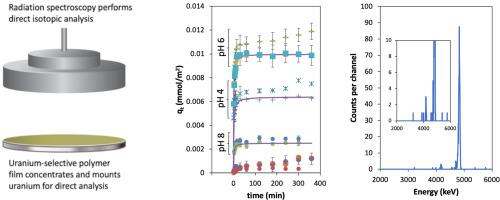Reactive & Functional Polymers ( IF 5.1 ) Pub Date : 2020-10-16 , DOI: 10.1016/j.reactfunctpolym.2020.104761 Abenazer W. Darge , Yugantar Gera , Timothy A. DeVol , Scott M. Husson

|
This contribution describes the development of reactive polymer films for the concentration of uranium from circumneutral pH solutions for spectroscopic analyses. These films were prepared by grafting uranium-selective polymers from polyethersulfone (PES) films via UV-initiated polymerization, and by introducing uranium-selective functional groups to polyacrylonitrile (PAN) films by chemical reaction. Ellipsometry was used to study poly(phosphoric acid 2-hydroxyethyl methacrylate ester) film growth kinetics on PES films. X-ray photoelectron spectroscopy of modified PAN films revealed conversion of nitrile groups to amidoxime groups to be as high as 40% and showed that the extent and depth of reaction could be varied precisely. Static uptake experiments with solutions of depleted uranium spiked with 233U were conducted to determine uranium binding capacities and kinetics of the modified polymer films at different pH values from 4 to 8. Sorption isotherm data were fitted to the Langmuir model, and the highest sorption capacities of 1.09 × 10−2 ± 1.03 × 10−3 mmol m−2 and 1.02 × 10−2 ± 3.00 × 10−3 mmol m−2 were obtained at pH 6 for modified PAN (M-PAN) and PES (M-PES) films. Capacities at pH 4 and 8 were lower and could be explained by differences in sorption mechanisms. Uranium batch uptake kinetics followed a pseudo-second order rate model. Equilibrium uptake was attained within 3 h for M-PAN film and 1 h for M-PES film. Alpha spectroscopy pulse height spectra were analyzed to study the role of selective layer film thickness on peak energy resolution. Full width at half maximum values from 29 to 41 keV were recorded for M-PAN film and from 26 to 45 keV for M-PES film. Whereas uranium uptake increased with selective layer film thickness and varied with polymer chemistry/extent of modification, the peak energy resolution was independent of layer thickness and polymer chemistry within the experimental measurement uncertainties. Results from this work are being used to guide the development of thin-film composite membrane-based detection methods for the rapid, fieldable analysis of radionuclides in water for nuclear forensics investigations and environmental studies.
中文翻译:

使用反应性聚合物薄膜进行铀浓缩以进行光谱分析
该贡献描述了用于从环境中性pH溶液浓缩铀以进行光谱分析的反应性聚合物薄膜的开发。这些膜是通过紫外线引发的聚合反应,从聚醚砜(PES)膜上接枝铀选择性聚合物,并通过化学反应将铀选择性官能团引入聚丙烯腈(PAN)膜中而制得的。椭偏法用于研究聚磷酸2-甲基丙烯酸2-羟乙酯酯在PES薄膜上的生长动力学。改性PAN膜的X射线光电子能谱显示腈基向a胺肟基的转化率高达40%,并表明反应的程度和深度可以精确地变化。掺入233贫铀溶液的静态吸收实验用U确定了在4至8不同pH值下改性聚合物膜的铀结合能力和动力学。吸附等温线数据拟合到Langmuir模型中,最高吸附能力为1.09×10 -2 ±1.03×10- 。 3 mmol m -2和1.02×10 -2 ±3.00×10 -3 mmol m -2在pH 6下获得了用于改性PAN(M-PAN)和PES(M-PES)膜的薄膜。pH 4和8下的容量较低,可以用吸附机理的差异来解释。铀分批吸收动力学遵循伪二级速率模型。M-PAN膜在3小时内达到平衡摄取,M-PES膜在1小时内达到平衡摄取。分析了阿尔法光谱脉冲高度光谱,以研究选择性层膜厚度对峰值能量分辨率的作用。对于M-PAN膜记录的半峰全宽为29到41 keV,对于M-PES膜记录的半峰全宽为26到45 keV。尽管铀的吸收随选择性层膜厚度的增加而增加,并随聚合物化学性质/改性程度的变化而变化,但在实验测量不确定性范围内,峰值能量分辨率与层厚度和聚合物化学性质无关。



























 京公网安备 11010802027423号
京公网安备 11010802027423号